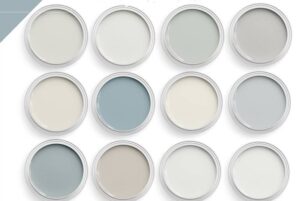The 1940s exterior house colors were typically light and earthy, with tans, beiges and other brown hues. The clean blank slate of white was a common color of this time along with bright brick reds as accents in trims, shutters and doors.
Let’s take a look at the typical exteriors of this decade to give you some inspiration on how to mimic these historic exteriors in your own home remodel or new construction project!
In the 1942s, World War II was in full swing, and like many things of the time, exterior house colors reflected that. Like previous decades of the 20th century, these colors were typically light and earthy, with tans, beiges and other brown hues.
The clean blank slate of white was a common color of this time along with bright brick reds as accents.
When painting the exterior of your home, choosing the right colors can be difficult – especially if you’re looking to replicate the look of an older house from the 1942s.
By combining multiple exterior house colors, you can create an authentic-looking exterior that’s perfect for year-round entertaining and enjoying time with family and friends in your yard or garden.
With these tips, you’ll have everything you need to replicate the 1940s exterior house colors on your own home!
1) Use pastel shades
If you want to emulate 40’s style, a great way to start is with your exterior house colors. Traditional shades of brown and tan work well, but it’s also important to consider a bright white shade. White exteriors were very popular in 1940, particularly on smaller homes and apartment buildings.
You can achieve a similar look by using one or two different pastel colors that blend well together. When choosing these colors, consider how they will wear over time and what type of upkeep they require.
2) Go Neutral With White
While light and earthy colors are common for exteriors of homes built in the 1942s, there’s also a surprising amount of white. This is partly because white paint was easy to come by and still is! and adds a refreshing, modern feel to older homes. If you love classic architecture but want your home to feel clean and bright, consider using a crisp, creamy white exterior paint on your house.
3) Use accent colors sparingly
It’s a common mistake to add too many colors to an exterior paint job. If you want to make your home look like it belongs in a different decade, try bright colors like greens, yellows and blues. But when painting older homes, try to stick with earth tones—they’re usually more flattering to a house’s historic style.
4) Don’t forget about the windows
The majority of your home’s natural light will enter through your windows, so you’ll want to think about light, bright colors if you want a space that’s pleasant and welcoming. Don’t be afraid to go all-white if that works best! There are plenty of options when it comes to window color we recommend going with semi-transparent shades so you don’t lose any natural light while maintaining privacy.
5) Consider your local building code before going all out
This is an important step before you start thinking about 1940s interior design ideas, as it’ll help to make sure your new home is up to snuff with local regulations. You can get in touch with your county or municipal building department and request a copy of your city’s building code, which will outline all codes and regulations you must abide by when constructing new buildings. Make sure that every component in your house meets these codes exterior paint included.
6) Residences That Use Red Accents
While most residences of that era were bright, earthy browns and whites, some homes showcased red accents. Red is an incredibly vibrant color, adding a bold punch to any interior. If you love red but want to make sure it fits in with your home’s style, try incorporating brick into your design red brick often includes plenty of white and gray hues that will help blend it into your space.
7) How Can I Make My Home Look Like It Came From This Decade?
Our designers from Overhead Door Company of Richmond are going to give you some tips on how to make your house look like it was built in the 40s. Paint is one of those things that can really transform a room and make it look amazing. It’s one of those cheap changes you can make that will really have an impact on your home.
8) How to decorate your exterior using color
The outside is where many homeowners like to set their own personal style. When it comes to design, the exterior color of a home is often a matter of taste, but certain color schemes can exude a sense of class or timelessness.
The best part about historic 1940s-era home colors is that you don’t have to know what schemes were in vogue at the time; Your paint dealer can help you choose a hue that suits your style and will also be durable enough to stand before Mother Earth. Find a matching color below.
Light and neutral colors
While it’s true that white was a common exterior color of homes built in 1940, it wasn’t necessarily a must-have. In fact, most 1942s-era homes were built with light, neutral colors like cream, tan and beige. Bricks, on the other hand most commonly seen in red were used as an accent or sometimes as a home’s entire siding.
With these bolder shades on display, many homeowners also added other accents like shutters and window boxes filled with colorful annual flowers for added character.
Brick Red Accents
Brick red is a popular color for house exteriors and interiors. It’s bold and vibrant and often blends well with other colors (such as gray, white or beige). The brick red was especially prominent in 1942s house colors, giving many homes a warm, lively appearance.
White exteriors
White houses have always been an eye-catching alternative to other exterior colors. It’s a classic look with a ton of versatility and can be paired with just about any kind of architectural style. Today, white is no longer reserved for historic or colonial architecture you can give your modern home a fresh white look that’ll help it stand out from its peers on either side of it.
Craftsman Style Homes
Craftsman homes were known for their tall, slender windows and boxy roof design. Most of these homes were made with cement siding, although a few natural wood designs also existed. Siding options included stone or brick veneer, wooden shakes or stucco. Like other homes of the 1940s, Craftsmans tended to have earth-toned exteriors and neutral white interiors. Brick red accents were common as well.
Traditional Design Homes
It’s no secret that living in a traditional home has been shown to increase one’s sense of happiness and overall wellbeing. While other housing styles are being explored for their environmental benefits, traditional design is unmatched in regards to both form and function. What does a traditionally designed home look like?
They typically feature tall ceilings, exposed brick walls, high windows (to let in lots of natural light), hardwood floors and woodwork throughout. The best part is that many of these elements can be used together or individually depending on your personal taste.
For example, high ceilings with large windows are a common classic exterior design feature while exposed brick walls are also popular amongst homeowners interested in simplifying their home decor without sacrificing warmth.
Tudor Style Homes
These homes, which were popular during the 1930s and 1940s, are characterized by details like steeply pitched roofs, protruding upper stories, bay windows and decorative half-timbering. Tudor is an English style that became popular in America in Colonial times.
These homes can be found throughout Long Island and New York City’s suburbs. Tudor houses today are typically made of wood with a stucco veneer and vary in color from reddish brown to blue-gray with white trim.
Manor Houses
Commonly built of wood and stone, these homes were large and simple in design. The 1940s saw a transition in manor houses from dark wood interiors to bright, open rooms with lighter wood. These estates were characterized by their warm colors and natural materials.
Overhanging roofs sometimes provided shelter for porches or walkways. Manor houses are still popular today with modern additions and renovations that update their style without sacrificing warmth.
9) How to find inspiration if you don’t have anything old in your neighborhood
If you don’t have any old homes in your neighborhood, there are plenty of other ways to find inspiration. Think back to all of your favorite movies and television shows: What colors did you see? Do a Google search for interior color schemes from that decade, then try picking out some hues from modern furniture stores like West Elm or Crate & Barrel. There are also great apps that can help.



